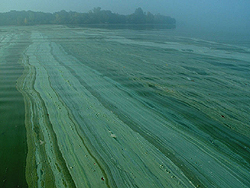 NEWS RELEASE
NEWS RELEASE
ALGOMA PUBLIC HEALTH
*************************
Algoma Public Health is advising residents and visitors of a confirmed blue-green algae bloom (cyanobacteria) on Bright Lake as of September 30, 2014.
A Bright Lake partner collected a sample on September 20, 2014.
The Ministry of Environment Lab confirmed the presence of Blue-Green Algae on September 30, 2014.
Cyanobacteria are microscopic organisms that are naturally present in lakes and streams, usually in low numbers.
However, the algae can become abundant in shallow, warm water that receives heavy sunlight.
While most cyanobacteria are not toxic, toxins can be produced in some algae blooms.
Depending on the particular cyanobacterium, and the amount to which one is exposed, blue-green algae may have the potential to cause a variety of adverse health effects, including rashes, skin and eye irritation, allergic reactions, gastrointestinal upset, and other effects.
There is a high potential for blue-green algae during this particular time of year and the public is encouraged to monitor other bodies of water and follow Algoma Public Health’s advisories.
Algoma Public Health advises if you see an algae bloom, you should not drink the water and do not:
- Bath or shower in the lake.
- Allow children, pets or livestock to swim in the water or drink the water.
- Cook with the water because food may absorb toxins from the water during cooking.
- Boil the water because boiling it may release more toxins into the water.
- Treat the water with a disinfectant like bleach. This may break open algae cells and release toxins into the water.
- Rely on water jug filtration systems, as they do not protect against the toxins.
- Eat the liver, kidneys, or other organs of fish caught in the water. Be cautious about eating the other parts of the fish caught in water where blue-green algae blooms occur.
Blue-green algae may look like thick pea soup, green, bluish, brownish, or reddish-green paint.
When it washes up on shore, it may look like a thick green mat.
If you have any other questions regarding blue-green algae in Bright Lake, the public can contact the Algoma Public Health at 705-356-2551.
Learn more about blue-green algae.
*************************